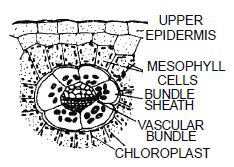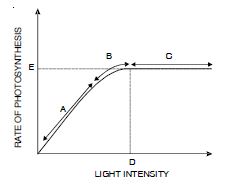Get a better understanding of complex concepts effectively and efficiently with free NCERT Solutions at Aasoka. These solutions cover the latest CBSE syllabus and are crafted by professionals. Students can also analyze their strengths and weaknesses with the help of the NCERT Solutions for Class 11 thus, in turn, strengthening their overall performance.
Through the chapter “Photosynthesis in Higher Plants” of Class 11 Biology, students will learn the site of photosynthesis, the structure of the photosynthetic machinery, pigments involved in photosynthesis, cyclic and non-cyclic photophosphorylation, C3 and C4 pathways, biosynthetic and photochemical phases of photosynthesis, factors affecting photosynthesis, chemiosmotic hypothesis, photorespiration, etc.
Question 1:
By looking at a plant externally can you tell whether a plant is C3 of C4? Why and how ?
Answer:
As compared to C3 plants, C4 plants are adapted to dry tropical regions. Such plants are able to tolerate high temperatures and show marked responses towards high light intensities. Also C4 plants have a greater productivity of biomass. However these C4 plants do not show any characteristics in external morphology.
Question 2:
By looking at which internal structure of a plant can you tell whether a plant is C3 or C4? Explain.
Answer:
By studying the anatomical details of the leaf, we can tell whether a plant is C3 or C4. C4 plants show typical Kranz anatomy.
The vein of the leaf is surrounded by bundle sheath which contains numerous chloroplasts. The mesophyll cells adjacent to bundle sheath also contain numerous chloroplasts. The chloroplast of mesophyll cells have well developed grana, while chloroplasts of bundle sheath have peripheral reticulum.
Kranz Anatomy.
Question 3:
Even though a very few cells in a C4 plant carry out the biosynthetic- Calvin pathway, yet they are highly productive. Can you discuss why ?
Answer:
Even though very few cells in a C4 plant carry out the biosynthetic - Calvin pathway, yet they are highly productive. These plants have two types of chloroplasts. The mesophyll chloroplasts fix atmospheric CO2 more effectively. They absorb CO2 even from a much low CO2 concentration, even when stomata are almost closed.
- C4 plants have a high value of net assimilation at high temperatures.
- Their rate of carbon assimilation is quite rapid.
- C4 plants perform photosynthesis even when stomata are closed.
- Their rate of net photosynthesis at full sunlight is as high as 40-80 CO2 / dm2 / hr.
Question 4:
Rubisco is an enzyme that acts both as a carboxylase and oxygenase. Why do you think Rubisco carries out more carboxylation in C4 plants ?
Answer:
Rubisco, i.e., ribulose biphosphate carboxylase-oxygenase is able to act as a carboxylase and oxygenase. This is because its active site can bind to both CO2 and O2. But actually rubisco has a much greater affinity for Co2 than O2. The relative concentration of CO2 and O2 determines which of the two will bind to the enzyme. In case of C4 plants, since there is a high concentration of CO2 at the enzyme site, so photorespiration does not occur. Therefore rubisco carries out more carboxylation in C4 plants.
Question 5:
Suppose there were plants that had a high concentration of Chlorophyll b, but lacked chlorophyll a, would it carry out photosynthesis ? Then why do plants have chlorophyll b and other accessory pigments ?
Answer:
If there were complete absence of chlorophyll a in a plant, it would not carry out photosynthetic activity at all because chlorophyll a is the chief pigment associated with photosynthesis as it traps light. Other accessory pigments like chlorophyll b, xanthophylls and carotenoids are equally essential as they also absorb light and transfer energy to chlorophyll a . They also enable a wider range of wavelength of incoming light to be utilised for photosynthesis and protect chlorophyll a from photo-oxidation.
Question 6:
Why is the colour of a leaf kept in the dark frequently yellow, or pale green ? Which pigment do you think is more stable ?
Answer:
The colour of leaf kept in dark frequently changes because of absence of chlorophyll in dark. Carotenoids and xanthophyll pigments are more stable.
Question 7:
Look at leaves of the same plant on the shady side and compare it with the leaves on the sunny side. Or, compare the potted plants kept in the sunlight with those in the shade. Which of them has leaves that are darker green ? Why ?
Answer:
The plants placed in light will have darker leaves as compared to leaves of a plant placed in shade. It is due to the fact that chlorophyll pigments will be more in light.
Question 8:
Figure shows the effect of light on the rate of photosynthesis. Based on the graph, answer the following questions :
Graph of light intensity on the rate of photosynthesis.
- At which point/s (A, B or C) in the curve is light a limiting factor ?
- What could be the limiting factor/s in region A ?
- What do C and D represent on the curve ?
Answer:
- A and B
- Light could be the limiting factor. Carbon dioxide concentration and quantity of water may be the limiting factors in region A.
- C is the maximum value of rate of photo-synthesis beyond which there is no further increase in the rate of photosynthesis. D is the light saturation point i.e. light intensity where the maximum amount of photosynthesis is achieved.
Question 9:
Give comparison between the following :
- Cyclic and non-cyclic photophosphorylation
- Anatomy of leaf in C3 and C4 plants.
Answer:
- Differences between cyclic and non-cyclic photophosphorylation.
- Differences in Anatomy of leaf in C3 and C4 plants.




